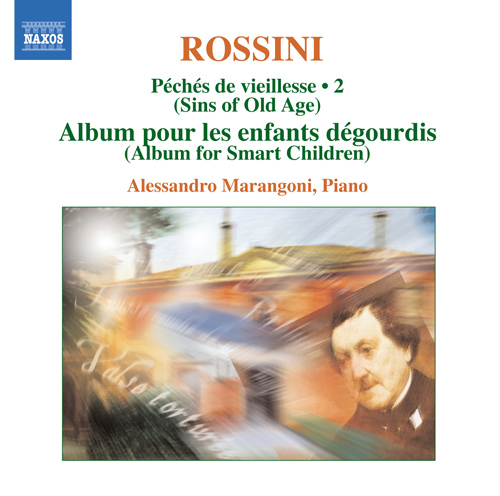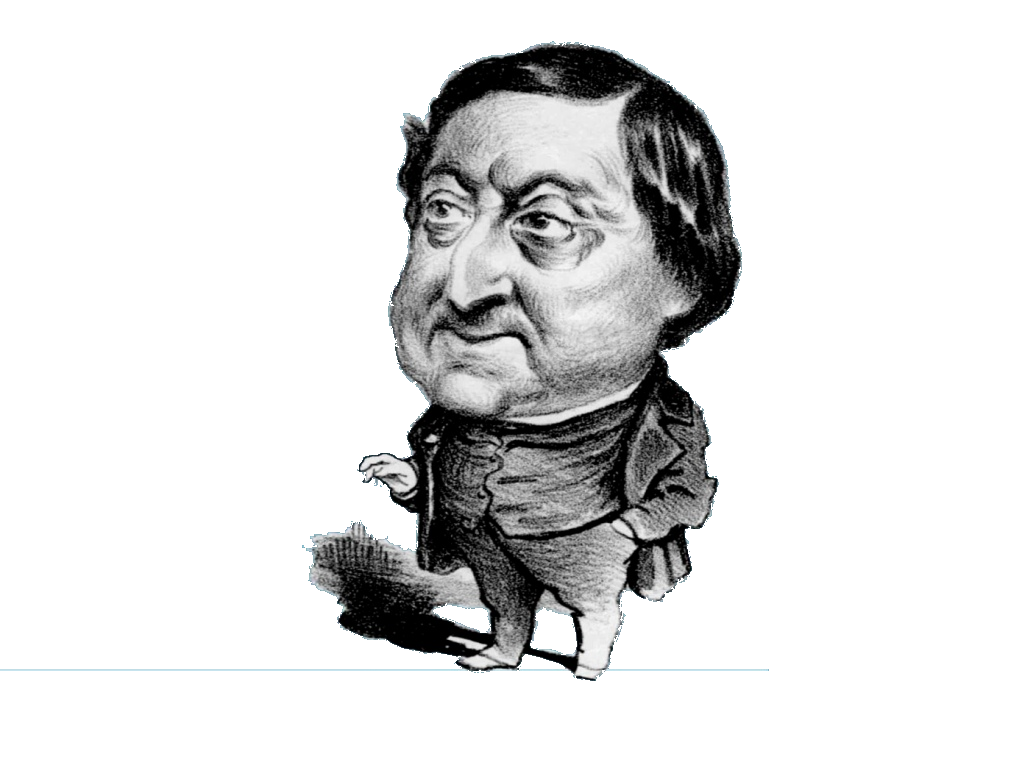 |
|
1 CD -
8.570766 - (p) & (c) 2009
|
|
| PÉCHÉS
DE VIEILLESSE - Volume 2 |
|
|
|
|
|
|
|
| Gioachino ROSSINI
(1791-1868) |
Péchés
de vieillesse - Volume VI "Album pour
les enfants dégourdis"
|
|
|
|
|
-
No. 1 - Mon prélude hygiénique du matin
|
|
7' 05" |
1 |
|
-
No. 2 - Prélude baroque |
|
7' 54" |
2 |
|
-
No. 3 - Memento homo
|
|
8' 14" |
3 |
|
- No. 4 - Assez de
memento: dansons |
|
4' 58" |
4 |
|
- No. 5 - La Pesarese
|
|
6' 01" |
5 |
|
- No. 6 - Valse torturée
|
|
6' 41" |
6 |
|
- No. 7 - Une caresse à
ma femme |
|
4' 45" |
7 |
|
- No. 8 - Barcarole
|
|
5' 24" |
8 |
|
- No. 9 - Un petit train
de plaisir comico-imitatif |
|
11' 19" |
9 |
|
- No. 10 - Fausse couche
de polka mazurka |
|
4' 32" |
10 |
|
- No. 12 - Un
enterrement en Carnaval
|
|
11' 07" |
11 |
|
|
|
|
|
Alessandro MARANGONI, pianoforte
Stenway & Sons (Angelo Fabbrini
collection)
|
|
|
|
|
|
Luogo
e data di registrazione |
|
Auditorium
di Mortara, Pavia (Italia) - 11-13
maggio 2007 |
|
|
Registrazione:
live / studio
|
|
studio |
|
|
Producer |
|
Edoardo
Lambertenghi |
|
|
Recording
engineer |
|
Edoardo
Lambertenghi
|
|
|
Editor |
|
Edoardo Lambertenghi
|
|
|
Assistant
producer
|
|
Paolo
Zeccara
|
|
|
Cover |
|
Paolo
Zeccara |
|
|
Edizione
CD |
|
NAXOS |
8.570766 | (1 CD) | durata 78' 00" |
(p) & (c) 2009 | DDD |
|
|
Note |
|
-
|
|
|
|
|
Gioachino
Antonio Rossini, one of the most
successful and popular operatic
composers of his time, was born
in Pesaro in 1792, five months
after the marriage of his
parents. His father, a
brass-player and later teacher
of the French horn at the
Bologna Accademia, had a modest
career, disturbed by the
political changes of the period
as the French replaced the
Austrians in Northern Italy.
Rossini’s mother was a singer
and as a boy Rossini made his
appearance with his father in
the pit orchestra and from time
to time as a singer with his
mother on stage, going on to
work as a keyboard-player in the
opera orchestra.
Rossini’s early studies in music
were with his father and mother,
and with other teachers through
the generosity of rich patrons.
In childhood he had already
started to show ability as a
composer and his experience in
the opera-house bore natural
fruit in a remarkable and
meteoric career that began in
1810 with the production of La
cambiale di matrimonio in
Venice.
There followed a series of
operas, comic and tragic, until
the relatively poor reception of
Semiramide in Venice in
1823 turned Rossini’s attention
to Paris. Under the Bourbon King
Charles X Rossini staged French
versions of earlier works and in
1829 Guillaume Tell. A
contract for further operas came
to nothing when the King was
replaced in the revolution of
1830 by Louis-Philippe, although
eventually, after some six
years, Rossini was able to have
his agreed annuity restored.
With matters settled in France,
in 1836 he returned to Italy and
in spite of ill health concerned
himself with the affairs of the
Liceo Musicale in Bologna. The
revolutionary disturbances there
in 1848, activities with which
he had little sympathy, seemed
to threaten him and his second
wife, Olympe Pélissier, whom he
had married in 1846, after the
death of his first wife, the
singer Isabella Colbran, from
whom he had been legally
separated since 1837. For his
own safety he moved first to
Florence, but in 1855, partly in
a search for better health,
returned to Paris. In that city
and a few years later at his new
villa at Passy he passed the
rest of his life.
Rossini’s last ten years brought
a return to composition,
principally with a series of
pieces described as Péchés
de vieillesse (Sins of Old
Age). Some of these are based on
earlier works, some designed for
performance at the informal
Saturday evenings when he
entertained guests in Paris, and
others simply musical obiter
dicta, as it were, pieces
written as the mood took him.
The Péchés de vieillesse
are included in thirteen
volumes, with the fourth to the
eighth grouped together by
Rossini as ‘Un peu de tout.
Recueil de 56 morceaux
semi-comiques pour le piano
(“Je dédie ces Péchés de
vieillesse aux pianistes de la
4.me classe à la quelle j’ai
l’honneur d’appartenir”)
(A little of everything.
Collection of 56 semi-comic
pieces for the piano: “I
dedicate these Sins of Old Age
to pianists of the fourth class,
to which I have the honour to
belong”). Rossini was unfairly
modest about his abilities as a
pianist, which were, it seems,
not inconsiderable. Other
volumes also contain piano
pieces.
The sixth volume of the Péchés
de vieillesse has the
title Album pour les enfants
dégourdis (Album for Smart
Children). It contains twelve
pieces, of which the eleventh, Etude
asthmatique, is here
omitted, to be included in a
later recording. The set starts
with Mon prélude hygiénique
du matin (My morning
hygienic prelude). The opening
flourish, a wake-up call, is
interrupted by chords of
Wagnerian solemnity, marked ppp,
before the lively principal
theme with its echoes of Chopin
is heard. The chords return, to
be followed, dolcemente,
by a brief aria, which makes its
due return in the tonic key of C
before the piece reaches its
emphatic conclusion.
The second piece, Prélude
baroque, after its
dramatic opening, seemed about
to promise reflection of
Rossini’s interest in earlier
music, but it is not long before
melodic language of the new
century finds a place, the two
elements providing a distinct
contrast.
The solemn C minor Memento
homo (Remember, O Man)
takes its title from the words
of the Ash Wednesday liturgy for
the distribution of the ashes; Memento,
homo, quia pulvis es,
et in pulverem reverteris
(Remember, O man, thou art dust,
and to dust thou shalt return).
It opens with the distant death
knell, sounding in the depths of
the keyboard, with music that
has been said to recall
Rossini’s Quelques mesures
de chant funèbre: à mon pauvre
ami Meyerbeer, a four-part
male chorus written on the death
of Meyerbeer in 1864. Mourning
and thoughts of death are thrown
aside abruptly in the following
light-hearted Assez de
memento: dansons (Enough
of Memento: let us dance), with
its constant left-hand
accompaniment and insouciant
twirls of melody.
In La Pesarese Rossini
turns to a melody from his
native town of Pesaro, presented
con grazia, but with a
suggestion of future
counterpoint in the imitative
entries of the main theme in a
central section.
The sixth piece, Valse
torturée, opens with
wayward introductory chords,
before the waltz proper starts,
a characteristic example of
Rossini’s familiarity with the
musical language of a younger
generation, the dance here
tortured by interruptions and by
its brusque first theme,
shifting to a less abrupt
secondary melody, and ending
with a wayward and prolonged
flourish.
With Une caresse à ma femme
Rossini offers an endearment to
his wife, Olympe Pélissier, who
had been a close companion since
the early 1830s. She did much to
care for Rossini during these
years, as his health and state
of mind fluctuated, coming to
serve as a nurse and his
protector from unwanted
intrusion, when that became
necessary. The piece is a
sincere tribute to a woman to
whom he owed much.
Barcarole, after its
introductory chords, embarks on
a lilting boating-song, with
more than an echo of Chopin,
mingled with more purely
Venetian inspiration.
There is an autobiographical
element in Un petit train de
plaisir,
comico-imitatif (A little
pleasure train,
comico-imitative). Train
journeys had not always proved
congenial to Rossini, and here a
bell summons the passengers, who
climb on board, before the train
starts its journey. The satanic
whistle blows, the brakes are
gently applied and the train
arrives in a station, where
Parisian beaux hand their girls
down from the coaches. The
journey continues, but the train
comes to grief in a dramatic
derailment. There are two
casualties, the soul of one
flying to heaven and the other
down to hell, followed by a
funeral march. The heirs express
their bitter sorrow in a
cheerful Allegro vivace
and Rossini ends with the words
‘Tout ceci est plus que naïf
c’est vrai’.
Fausse couche de polka
mazurka (Miscarriage Polka
Mazurka) matches the ironical
suggestion of its title, as the
promised dance occasionally
miscarries.
The album ends with Un
enterrement en carnaval (A
Carnival Interment) which
reveals its initially funereal
character in the muffled drums
represented by tremolo bass
octaves. A shift from B minor to
G major brings a less mournful
mood, before the drums of the
first section return, fading to
a carnival D major Allegro
moderato, with a gentler
meno mosso at its heart.
Keith Anderson
|
|

